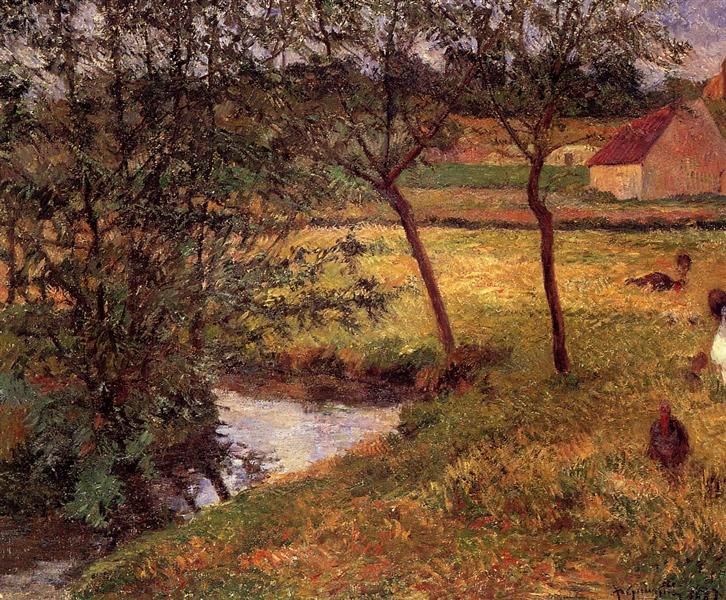Tanım
Paul Gauguin's painting "Stream at Osny" (1883) is a work that encapsulates the intersection of Impressionism and the later developments towards a more personal and symbolic style that would characterize his career. In this work, Gauguin presents a serene and contemplative landscape, where water and vegetation play leading roles in a composition that breathes the idyllic atmosphere of nature.
The work is dominated by a palette of greens, blues and browns, reflecting the calm and tranquillity of the surroundings. The stream itself gently glides in the foreground, creating a visual narrative that invites the viewer into a space of reflection and peace. The green hues of the foliage on the banks of the stream combine with the blue of the water, while subtle nuances of light filter through the landscape, capturing the quality of the daytime moment.
The composition is notable for Gauguin’s use of spatial arrangement. The lines of the stream guide the viewer’s eye through the painting, creating a sense of movement within a static frame. To the right, dense vegetation and shadows add palpable depth while above, the clear sky reinforces the serenity of the setting. This use of space and colour reinforces the idea of an almost utopian place, a refuge from the bustle of urban life that Gauguin would begin to explore more deeply in his later years in Brittany and Tahiti.
Unlike many of his later works in which he focused on human figures and symbolic themes, "Stream at Osny" maintains an almost contemplative approach, absent of direct human presence. However, this does not detract from the work; instead, it suggests a sense of connection and harmony with nature, a recurring theme in his work and that of other Impressionists who sought to capture the essence of the fleeting moment.
Gauguin, although often associated with Symbolism and its later explorations of exotic themes, here shows his Impressionist roots, in which light, colour and atmosphere are central. The work can be seen as a bridge between the Impressionist art of the late 19th century and the more radical exploration that the artist would undertake later on. This can be seen in similar works by other artists of the period who explored light and colour, such as Claude Monet, whose technique of loose brushstrokes and focus on nature also influenced Gauguin.
As a whole, “Stream at Osny” is not only a depiction of a landscape, but also serves as a testimony to Gauguin’s artistic journey, marking a transitional moment in his evolution towards a more personal and symbolic style. As the viewer moves through the painting, he or she is also immersed in the author’s sensitivity to a natural world overflowing with vibrant colors and shapes that not only observe, but also convey a deep connection with what surrounds us. This work, therefore, is an echo of a time and place that invites silent contemplation and stillness, qualities appreciated and necessary in the hectic art world of the late 19th century.
KUADROS ©, a famous painting on your wall.
Hand-made oil painting reproductions, with the quality of professional artists and the distinctive seal of KUADROS ©.
Painting reproduction service with satisfaction guarantee. If you are not completely satisfied with the replica of your painting, we will refund 100% of your money.

